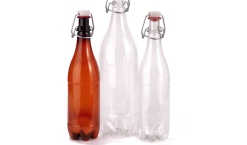
Glass Container Industry Releases Comprehensive Cradle-to-Cradle LCA
By Canadian Packaging Staff
General Glass container industry
The North American glass container industry has produced the first complete and thorough cradle-to-cradle life cycle assessment (LCA) ever conducted for the industry by the Glass Packaging Institute (GPI), a trade association representing the North American glass container industry. The study shows that the use of recycled glass (cullet) in manufacturing results in a decrease in primary energy demand and reduces carbon emissions.
A ‘cradle-to-cradle’ LCA includes the entire cradle-to-grave life cycle of a product while factoring in the recycling of the used product back to its original purpose.
“The LCA confirms the industry is on the right track with the goal to use 50 percent recycled glass in the manufacture of new glass bottles and jars by the end of 2013,” states Joseph Cattaneo, president of the GPI. “In creating more recycling awareness and working to improve recycled glass collection, the industry is helping boost the cullet content in manufacturing. The study shows increased cullet helps reducing energy emissions, conserve raw materials, extend the life of glass manufacturing furnaces, and save energy.”
While other industries claim that the transportation of glass bottles has more of an environmental impact because of the weight of the containers, a key finding of the LCA dismisses this claim. The transportation of raw materials and cullet used in glass production represents less than four to five percent of the total energy used in the production of container glass.
While each glass container has its own carbon profile, on average, existing recycle rates offset the CO2 burden when shipping foods and beverages across America. The 50 percent content rate will only serve to further reduce carbon emissions. Therefore, when examining the entire life cycle of a packaging material, one must also consider the environmental impact of raw material extraction, production, transportation and end use treatment. The conclusion: when looked at it in its entirety, the environmental benefits stemming from the recycling of glass containers more than offset any increased impact generated by slightly heavier containers.
“The North American glass container industry purposely conducted a cradle-to-cradle LCA to obtain a total picture of our industry’s environmental impact,” says Cattaneo. “We knew that for an LCA to be useful and to serve as an appropriate benchmark, it had to be cradle-to-cradle. For consumers and retailers to be able to compare the environmental impact of one packaging material to another, all industries should consider conducting complete life cycle analyses. Only then will we have clarity.”
Glass containers are endlessly recyclable, made from all-natural ingredients (sand, soda ash, limestone, and recycled glass), and glass is the only packaging material accepted by the U.S. Food and Drug Administration (FDA) as “GRAS” or “generally recognized as safe” for food and beverage contact.
A leading sustainability consulting firm, PE Americas, conducted the study examining each step from raw material extraction to end-use. The closed-looped cradle-to-cradle LCA collected data from 105 furnaces representing 75 percent of North American glass container production.
For the complete report and more information on the North American glass container industry LCA, please visit www.gpi.org/LCA.
Advertisement

